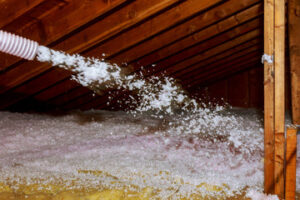Adding new insulation can improve the energy efficiency of your home. However, it can also cause structural damage if not done correctly. This is why removing old insulation is so important.

A powerful Insulation Removal Perth vacuum and heavy-duty bags for disposal are essential tools for this task. It is also a good idea to wear gloves and a dust mask to protect yourself from cellulose insulation particles.
Regardless of whether you need to replace old insulation or just want to upgrade the R-value in your home, you should know that there are various associated costs. These costs include labor and the cost of the materials used in the replacement process. You may also need to spend money on other services such as repairing the roof or moving electrical wires. You should also factor in the cost of disposing of the old insulation.
The price of insulation removal depends on the type of material and the location of the attic or other space where it’s located. Fiberglass batts or rolls are usually the most affordable option, while cellulose or spray foam can be more expensive. The size of the attic and its accessibility are also important factors in the cost of insulation removal. If the insulation is in a hard-to-reach spot, such as a crawl space or basement, expect to pay more.
If your home’s insulation is in poor condition, you should have it removed as soon as possible. It will no longer be effective at regulating the temperature and could lead to increased energy bills or damage to your home’s structure. A qualified professional can recommend the best course of action for your situation, including removing and installing new insulation.
In addition to its ineffective insulating properties, damaged or contaminated insulation can cause health issues and damage to your home. The presence of mold or animal waste can make breathing difficult, and if the insulation is affected by fire, it can pose a significant health risk.
Besides improving your home’s energy efficiency, a new insulation installation can prevent heat loss in the winter and heat gain in the summer. Moreover, it can reduce your utility bills and provide you with a more comfortable home.
The best type of insulation to install is cellulose, which has a higher R-value than fiberglass. It also has the advantage of being moisture resistant and fungus-resistant. You should hire a reputable company to handle the installation, as it will ensure that your home is safe and energy-efficient.
Preparation
A home’s insulation is vital to regulating its temperature. However, if it is damaged or contaminated, it can no longer be effective. This may lead to higher energy bills and a less comfortable home. Insulation removal and replacement can significantly reduce these costs, as well as improve the safety and comfort of a house.
Before the actual removal process, it is essential to prepare the attic space. This can include clearing away any debris or obstacles that could impede the removal process. It is also recommended to lay down protective coverings over surfaces that could be harmed by debris or dirt particles during the process. The attic space should also be inspected to identify any areas that need special attention or repair.
Once the attic space is cleared, it is time to start removing old insulation. This can be done by hand or by machine, depending on the type of insulation and damage. For example, blown insulation can be removed using a vacuum system, while fiberglass, cellulose and rock wool insulation must be bagged and raked out by hand. It is also important to consider the presence of hazards in the attic, such as mold, animal feces, or asbestos, which require extra precautions and special disposal methods.
The cost of removing and replacing insulation can vary greatly depending on the type of material and the extent of the damage or contamination. It is best to hire a professional insulation removal company to ensure that the job is completed correctly and safely.
A good insulation company should offer a variety of services and be licensed and insured to provide their services in your area. They should also have specialized training in different types of insulation, including fiberglass, cellulose, and spray foam. The right contractor will know how to properly handle each of these materials and use the appropriate tools for their safe and efficient removal.
If your home’s insulation is in need of removal, it’s important to act quickly. Delaying the process can cause serious problems, including higher energy bills and health issues. In addition, damaged or contaminated insulation can harbor pests and moisture, leading to costly damage to your home.
Safety
Insulation removal is a complex process that involves accessing spaces within walls and attics, disposing of hazardous materials, and addressing safety concerns. It’s important to understand the risks involved and adhere to strict safety protocols to ensure that workers and residents are protected.
Professionals typically start with a risk assessment to identify any environmental hazards, including asbestos contamination. They then develop a comprehensive removal plan to minimize potential dangers and ensure that all contaminants are properly handled and disposed of. Depending on the type of insulation, they may also use different tools and methods to safely remove it.
For example, spray foam insulation is often softened with a solvent before scraping it away. This reduces the risk of damaging the walls and prevents mold and pests from developing. The team will also ensure that any contaminated materials are sealed off from unaffected areas of the building and safely transported for disposal.
Before the process begins, it’s essential to clear the workspace and inspect the area for any hazards that might be present. In attics, this could mean identifying and disconnecting live wires to avoid accidental contact that could lead to fire or electric shock. It’s also a good idea to clear out any storage items or clutter from the attic space to create a clean working environment.
To protect themselves from harmful particles and contaminants, professionals wear appropriate protective gear during insulation removal. This includes gloves, goggles, and a respirator mask. They also ensure that any ventilation systems are functioning properly to limit the spread of contaminants throughout the home or office.
Hiring a professional company is often the best option for large-scale projects, particularly when it comes to older insulation that may contain toxic materials like asbestos. In addition to reducing the risk of exposure, professional services can help homeowners improve their energy efficiency and save money on utility bills. They can also recommend the latest solutions for enhancing home performance and ensuring healthy indoor air quality.
Reputation
Insulation Removal is a necessary step in ensuring your home’s comfort and efficiency. Insufficient or outdated insulation can harbor rodents, insects, and molds, leading to poor indoor air quality and a strain on heating and cooling systems. It can also damage the underlying materials, such as drywall and support studs, and can pose safety risks. Replacing old insulation with new material prevents these problems and offers other benefits, including energy savings.
It’s important to choose a reputable insulation removal service that has experience in your type of home and can provide references from past clients. In addition, you should ask the company about its safety protocols and whether it complies with local regulations regarding the disposal of hazardous materials, such as asbestos. You should also ask for detailed estimates and cost breakdowns to determine if your project will be affordable.
A reliable insulation removal service should use a vacuum or manual process to remove the insulation and dispose of it properly. They will seal off the work area and take precautions to ensure that contaminants do not spread to other parts of your home. They will also follow strict safety protocols when dealing with potentially dangerous materials like asbestos to ensure their employees’ and homeowners’ health and well-being.
Damaged insulation can become breeding grounds for mold and mildew, which can trigger respiratory issues in sensitive individuals. It can also lose its effective insulating capabilities due to gaps, voids, or compression. Professional insulation removal services can address these issues, restoring the integrity of the underlying structure and ensuring maximum energy efficiency.
Insulation removal is often a necessary part of remodeling projects or home renovations, especially when changing the size or layout of rooms that house insulation. It can be particularly beneficial in older homes with outdated insulation or a poorly-installed system, which can lead to poor indoor air quality and higher utility bills.
In addition to reducing costs, installing new insulation can increase your property value and make the home more attractive to prospective buyers. It can also help maintain the home’s environmental and structural health by preventing pest infestations, mold growth, and moisture buildup.
